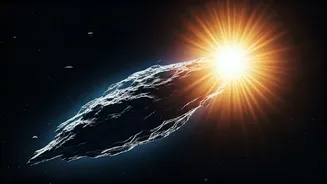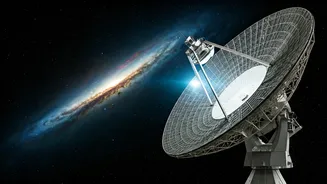Comet ATLAS Returns
The interstellar comet 3I/ATLAS is back in the news thanks to the appearance of fresh images that quickly went viral. This celestial body has attracted
particular attention from both astronomers and enthusiasts of extraterrestrial life. The comet's trajectory and its behavior near the sun are key elements in the current discussions. It successfully endured intense solar radiation, a feat that has surprised many in the scientific community. The images provide strong evidence of the comet's continued existence, stirring the scientific community and amateur stargazers alike. The comet's unexpected resilience and recent imagery have provided material to re-ignite hypotheses concerning the nature of the comet and the potential presence of extraterrestrial life. Its recent survival and the new photographic evidence are at the center of the renewed attention.
Solar Survival Challenge
One of the most remarkable aspects of comet 3I/ATLAS is its ability to withstand the intense heat and radiation of the sun. The comet navigated a close passage to the sun, a journey that many scientists thought would lead to its complete disintegration. The survival of the comet has raised questions regarding the comet's composition and structure. The resilience of the comet has offered a window into the characteristics of interstellar objects and the environment from which they originate. This event has challenged conventional predictions about cometary behavior, and fueled speculation about its properties. The comet's survival offers a chance to look at how these types of celestial objects can be more durable than previously assumed. This survival also opens the door to deeper research into interstellar objects and their resilience in harsh environments.
Alien Theories Ignite
The new images and the comet's survival have provided a catalyst for discussions on extraterrestrial life. Some individuals point towards the unusual characteristics of the comet as possible indications of alien technology or involvement. This argument suggests that the comet could be a form of interstellar probe or a vessel of alien origin. While mainstream scientists are more cautious in their interpretation, the data supports ongoing debate. This phenomenon has spurred discussions on the possible nature of the comet and the likelihood of discovering signs of life beyond Earth. These theories are largely based on the comet's unexpected endurance and the intriguing nature of its journey. The interest has also brought more awareness to the search for signs of alien life.
What’s Next for ATLAS?
The scientific community will likely shift to a more detailed examination of 3I/ATLAS. Researchers will certainly try to gather more data on its composition, trajectory, and interaction with the solar wind. Further analysis will concentrate on the composition of the comet to shed light on its history and origin. The continuing study will hopefully aid in understanding the broader population of interstellar objects. Scientists hope to get new insights into the makeup of this interstellar comet. The data gathered from ATLAS may contribute to the ongoing quest to study the potential of alien life in our universe. Future missions and observation programs may be created based on the analysis of these images, promising further investigation into this interstellar visitor.














